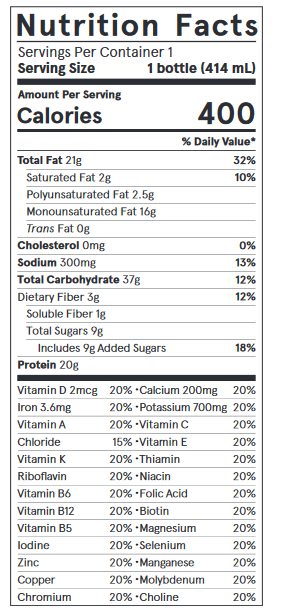Let's see how my 4 ingredient, $1.50 per serving fried rice recipe stacks up against Soylent 2.0 beverage.
Soylent 2.0 drink is 400 calories, $2.69 USD per serving with a subscription. I've formulated a very simple, very cheap 4 ingredient fried rice recipe to be nutritionally comparable. Now let's see how they compare.
*Background: I work in the food industry and have access to professional product development software, which lets me play around with food concepts and estimate what they look like on paper (nutritional information, cost, allergens, claims, etc) quite easily. I'm not suggesting anyone eat only Soylent or fried rice to survive, this is just a friendly reminder that simple, cheap, easy cooking can stand up to slick marketing corporations put behind their products.
Soylent's Nutritional Info
The 400 calories are made up of 20g of protein, 37g of carbs (9g of added sugar), 21g of fat. The micro nutrients (vitamins and minerals) are all exactly 20% Daily Value because they are supplemented directly as isolated vitamin and mineral salts.

The cost of this product is $2.69 US per serving with a monthly subscription. It is cheaper if you subscribe to buy more. There is no arguing that is a good price for a prepared meal, even if you can call this a meal. Strangely, Soylent advertises with a cost per calorie metric. This is a quite useless metric as simple calories could be obtained A LOT cheaper than Soylent. The point of a meal replacement product like Soylent is to cover a wide range of nutrients. Even using this metric to compare other meal replacements won't give you a good idea of value as the most expensive ingredients tend to be the protein sources and micro nutrients (vitamins, minerals, etc), which are a minor contributor to the caloric content. Carbs and fats, the major contributor of calories are much cheaper. If you want to get really silly and compare $ per 400 calories of foods, 44g or 400 calories of pure canola oil would only cost about $0.13.
My Fried Rice Nutritional and Cost Breakdown
Recipe
The ingredients are simple (per serving):
2 large eggs
1 cup prepared cold brown rice (1/3 cup dry)
1/4 cup green bell pepper, chopped
1/4 cup frozen or fresh green peas
Salt and pepper to taste
The instructions are simpler. In fact, I'm not going to give instructions for fried rice, sorry. I'll just say that you can scramble the egg into the rice, or add it fried on top. That will make no difference.
If you would like an ingredient breakdown of Soylent, please see my other post on the topic.
Nutrients of My Fried Rice

| Nutrient | My Fried Rice | Soylent 2.0 |
|---|---|---|
| Calories | 430 | 400 |
| Protein | 18 | 20 |
| Carbs | 48 | 37 |
| Fat | 18 | 21 |
| Cost | $1.50 | $2.69 |
Here are the individual ingredient's nutrient contribution:

Protein - So my recipe starts with a very affordable $0.25 chicken egg, which is a great source of protein and has almost all nutrients humans require. Two eggs plus the small amount of protein in the other ingredients almost gets us to 20g per serving (18g). Oh yea, don't try to live on chicken eggs, they have no Vitamin C. I don't want you to get scurvy like so many sailors before you. Enter the green bell pepper, a super source of Vitamin C.
Carbs - For tasty carbs with a good source of fibre, yummy brown rice. 1 cup of cooked rice (about 1/3 cup dried) should get us close to 400 calories. So my recipe has more total carbs (me 48g, them 37g), more fibre (me 4g, them 3g), less sugar (me 3g, them 9g) and no added sugar (them 9g).
Fats - Soylent has me beat in the fats department, as they add a premium vegetarian friendly algae-extracted omega-3 fatty acid supplement. My fats are mostly from the chicken eggs and bit of sunflower oil for frying.
Vegetables - A total of 1/2 cup (1/4 peppers + 1/4 peas) gives us 1 serving of vegetables, awesome. Soylent has 0 servings of vegetables. It does not contain beets as they claim on their website.
Cost

The total cost for a serving of this meal is about $1.60 Canadian, so somewhere a bit shy of $1.50 USD. Personally I would add some extra seasoning or sauce, my favourite for fried rice is sweet chili sauce.

Conclusion
This is a flawed comparison of course, one of these requires cooking, one does not. One of these is vegan, one is not. There are a lot of nutritional aspects I haven't covered here. I'm not sure nutritional dissections like this are particularly useful, since it is not necessary or practical approach to eating or nutrition. I hope however this was a reminder that simple, traditional, easy, cheap, real cooking is awesome and everyone can find time to do something as simple as fried rice.
Again, great post. Perhaps my comment on your previous article was lost in the haze. I'm an independent film-maker from Amsterdam currently working on a documentary about these types of food replacements.
Would really like to get in touch with you!